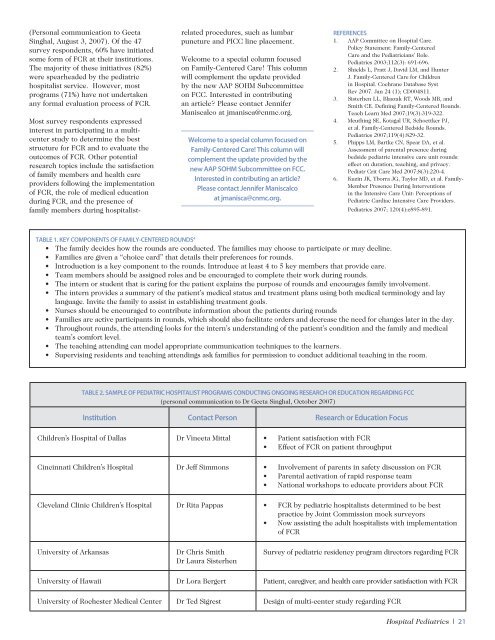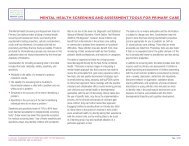Susan Wu, MD, FAAP, Editor - American Academy of Pediatrics
Susan Wu, MD, FAAP, Editor - American Academy of Pediatrics
Susan Wu, MD, FAAP, Editor - American Academy of Pediatrics
Create successful ePaper yourself
Turn your PDF publications into a flip-book with our unique Google optimized e-Paper software.
(Personal communication to Geeta<br />
Singhal, August 3, 2007). Of the 47<br />
survey respondents, 60% have initiated<br />
some form <strong>of</strong> FCR at their institutions.<br />
The majority <strong>of</strong> these initiatives (82%)<br />
were spearheaded by the pediatric<br />
hospitalist service. However, most<br />
programs (71%) have not undertaken<br />
any formal evaluation process <strong>of</strong> FCR.<br />
Most survey respondents expressed<br />
interest in participating in a multicenter<br />
study to determine the best<br />
structure for FCR and to evaluate the<br />
outcomes <strong>of</strong> FCR. Other potential<br />
research topics include the satisfaction<br />
<strong>of</strong> family members and health care<br />
providers following the implementation<br />
<strong>of</strong> FCR, the role <strong>of</strong> medical education<br />
during FCR, and the presence <strong>of</strong><br />
family members during hospitalist-<br />
related procedures, such as lumbar<br />
puncture and PICC line placement.<br />
Welcome to a special column focused<br />
on Family-Centered Care! This column<br />
will complement the update provided<br />
by the new AAP SOHM Subcommittee<br />
on FCC. Interested in contributing<br />
an article? Please contact Jennifer<br />
Maniscalco at jmanisca@cnmc.org.<br />
Welcome to a special column focused on<br />
Family-Centered Care! This column will<br />
complement the update provided by the<br />
new AAP SOHM Subcommittee on FCC.<br />
Interested in contributing an article?<br />
Please contact Jennifer Maniscalco<br />
at jmanisca@cnmc.org.<br />
TABLE 2. SAMPLE OF PEDIATRIC HOSPITALIST PROGRAMS CONDUCTING ONGOING RESEARCH OR EDUCATION REGARDING FCC<br />
(personal communication to Dr Geeta Singhal, October 2007)<br />
Institution Contact Person Research or Education Focus<br />
Children’s Hospital <strong>of</strong> Dallas Dr Vineeta Mittal • Patient satisfaction with FCR<br />
• Effect <strong>of</strong> FCR on patient throughput<br />
Cincinnati Children’s Hospital Dr Jeff Simmons • Involvement <strong>of</strong> parents in safety discussion on FCR<br />
• Parental activation <strong>of</strong> rapid response team<br />
• National workshops to educate providers about FCR<br />
Cleveland Clinic Children’s Hospital Dr Rita Pappas • FCR by pediatric hospitalists determined to be best<br />
practice by Joint Commission mock surveyors<br />
• Now assisting the adult hospitalists with implementation<br />
<strong>of</strong> FCR<br />
University <strong>of</strong> Arkansas Dr Chris Smith<br />
Dr Laura Sisterhen<br />
REFERENCES<br />
1. AAP Committee on Hospital Care.<br />
Policy Statement: Family-Centered<br />
Care and the Pediatricians’ Role.<br />
<strong>Pediatrics</strong> 2003;112(3): 691-696.<br />
2. Shields L, Pratt J, David LM, and Hunter<br />
J. Family-Centered Care for Children<br />
in Hospital. Cochrane Database Syst<br />
Rev 2007. Jan 24 (1); CD004811.<br />
3. Sisterhen LL, Blaszak RT, Woods MB, and<br />
Smith CE. Defining Family-Centered Rounds.<br />
Teach Learn Med 2007;19(3):319-322.<br />
4. Meuthing SE, Kotagal UR, Schoettker PJ,<br />
et al. Family-Centered Bedside Rounds.<br />
<strong>Pediatrics</strong> 2007;119(4):829-32.<br />
5. Phipps LM, Bartke CN, Spear DA, et al.<br />
Assessment <strong>of</strong> parental presence during<br />
bedside pediatric intensive care unit rounds:<br />
effect on duration, teaching, and privacy.<br />
Pediatr Crit Care Med 2007;8(3):220-4.<br />
6. Kuzin JK, Yborra JG, Taylor <strong>MD</strong>, et al. Family-<br />
Member Presence During Interventions<br />
in the Intensive Care Unit: Perceptions <strong>of</strong><br />
Pediatric Cardiac Intensive Care Providers.<br />
<strong>Pediatrics</strong> 2007; 120(4):e895-891.<br />
TABLE 1. KEY COMPONENTS OF FAMILY-CENTERED ROUNDS 4<br />
• The family decides how the rounds are conducted. The families may choose to participate or may decline.<br />
• Families are given a “choice card” that details their preferences for rounds.<br />
• Introduction is a key component to the rounds. Introduce at least 4 to 5 key members that provide care.<br />
• Team members should be assigned roles and be encouraged to complete their work during rounds.<br />
• The intern or student that is caring for the patient explains the purpose <strong>of</strong> rounds and encourages family involvement.<br />
• The intern provides a summary <strong>of</strong> the patient’s medical status and treatment plans using both medical terminology and lay<br />
language. Invite the family to assist in establishing treatment goals.<br />
• Nurses should be encouraged to contribute information about the patients during rounds<br />
• Families are active participants in rounds, which should also facilitate orders and decrease the need for changes later in the day.<br />
• Throughout rounds, the attending looks for the intern’s understanding <strong>of</strong> the patient’s condition and the family and medical<br />
team’s comfort level.<br />
• The teaching attending can model appropriate communication techniques to the learners.<br />
• Supervising residents and teaching attendings ask families for permission to conduct additional teaching in the room.<br />
Survey <strong>of</strong> pediatric residency program directors regarding FCR<br />
University <strong>of</strong> Hawaii Dr Lora Bergert Patient, caregiver, and health care provider satisfaction with FCR<br />
University <strong>of</strong> Rochester Medical Center Dr Ted Sigrest Design <strong>of</strong> multi-center study regarding FCR<br />
Hospital <strong>Pediatrics</strong> | 21



